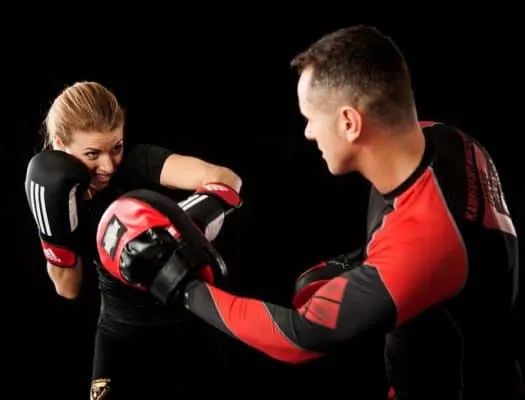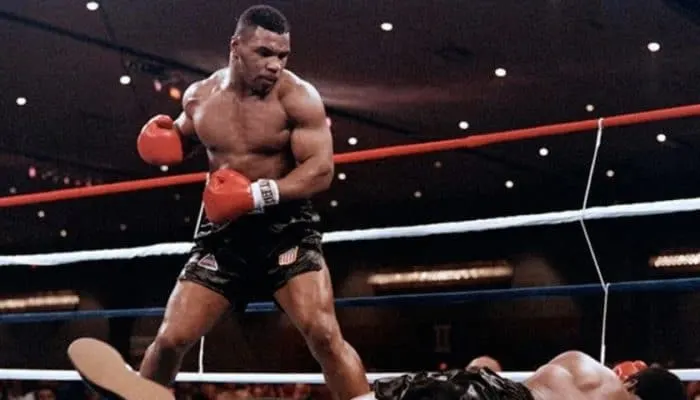
If you’ve ever watched MMA, you’ll know that there has always been competition around which fighting technique is best. In reality, the main thing we should know is how to defend ourselves against an attacker. Boxing in particular is very popular, but can appear to be more weighted towards offensive strikes. This raises the question whether boxing is also good for self-defense.
Boxing is good for self-defense because it teaches you how to block an attacker and fight them if necessary. Boxing also improves fitness, strengthens motor skills and mentally prepares you for a fight. However, people often learn another martial art so they can also fight on the ground if required.
I will discuss the benefits of boxing as self-defense in more detail below. It is also important to know the disadvantages of boxing and why people will often combine this with another martial art.
Why Boxing is Good for Self Defense
Boxing teaches you a wide range of skills that can be very effective in a self-defense situation.
1. Blocking Strikes
Not only will a boxer learned to strike their opponent with their fists, they will also learn how to defend themselves against those strikes. Therefore, if you learn all the different ways to strike an opponent with your fists, you will be prepared for any punch your attacker may throw at you.
Blocking can involve a variety of techniques. The most common is protecting your head and body with your arms. Boxers are taught to keep their arms up so that can move them quickly to their face to block a punch.
Another technique is the light footwork. The lighter you are on your feet, the easier it is to evade your attacker. A boxer’s stance allows them to shift their weight back and forth between their feet to change direction at a moment’s notice.
Finally, boxers are trained to use their muscles for self-defense. When evading oncoming strikes, they will keep their muscles loose to move out the way. When bracing for impact, they will tense up their muscles so that the bones or organs underneath will be protected.
Bracing immediately after a strike will also prevent whiplash, which can contribute to concussion or being knocked out.
2. Striking Accuracy
As I mentioned earlier, you will learn many different types of punches, but also how to execute them well. There is an art to increasing the power, speed and accuracy of your punch. With practice, you will get close to perfecting these skills.
Once you have an understanding of different punches, you will be able to recognize which punches your attacker uses. This means you will know, not only how to block that punch, but which counterattack to use to be most effective.
A boxer’s stance will help to ground their strikes. Planting your foot and swinging your hips gives a punch much more power than if you were to just use the strength of your shoulders.
Although it may not be your original intention to cause your opponent damage in a self-defense situation, doing so can stun or knock out your opponent, giving you time to escape. Sometimes, if faced with multiple attackers, you could use your knowledge to neutralize one and defend against the other.
3. Discipline
A very good lesson in boxing is that you should never seek a fight. The discipline that a boxer must demonstrate in training helps to take the emotion out of the fight so that they can keep a level head.
If you remain calm, you will be able to see the futility of a fight and hopefully avoid more fights. You will also be able to moderate your strikes and defense so that you find a balance between subduing your attacker and escaping.
4. Fitness
Boxing can provide a well-rounded workout. Not only do you use the muscles in your upper body, but you also use those in your hips, thighs and calves, etc. I will explain this in greater detail further on.
This full-body workout at each training session will greatly improve your fitness. If you are running, jumping, striking and weight-lifting at every training session for an hour, you will be able to withstand the intensity of a holding off your attacker and have the endurance to escape when you get the opportunity.
5. Stability
Having light feet and a good stance is what helps keep boxers from being knocked to the ground. Boxers do their best work in face to face combat, so it is important for them to learn how to remain stable on their feet.
If they do happen to get knocked to the ground, boxers are taught to recover quickly to their feet. They also do this in a way that protects them from being knocked down again on the way up.
6. Motor Skills
There are certain motor skills that you will develop in boxing that will come in handy in a self-defense situation.
Firstly, boxers are taught to maintain eye contact with their opponent so that they can watch every move they make and react accordingly. This develops excellent hand-eye coordination.
This also develops a rapid reaction time. By keeping your eye on your attacker at all times, you learn to react faster than before. The more you practice, the better your brain will become at anticipating your opponent’s moves.
Another great motor skill is your reflexes. These are movements that occur without having to think about them. After training for a while, you should notice your reflexes improve. This means you are able to have your mind on something else while your body begins defending itself.
This is particularly important if you are attacked from behind, being caught unaware. In this scenario, your reflexes will kick in faster, giving your brain time to catch up and register what is happening. This also gives you more time to work out what you should do about it.
7. Mental Preparation
If you are sparring with others on a weekly basis, you will become increasingly familiar with the fighting environment. You will begin to feel more comfortable with the idea of facing an opponent that has the potential to beat you.
You will also become more familiar with getting hit in the head and stomach. If you are not used to these strikes, you could potentially become stunned if this happens to you in a street fight. This is something that could mean the difference between life and death. You can’t afford to stand there, stunned.
8. Confidence
The final benefit that boxing can offer in a self-defense situation is confidence. When you know that you’ve faced trained opponents before, on a regular basis, you should feel more confident facing a (most likely) untrained opponent.
From your training sessions, you will know that you are capable of blocking a hit and landing some of your own punches if necessary. Similar to what discipline offers, having confidence will help you think more clearly in the situation.
Your movements will be more controlled and you can read the attacker/situation better when you are feeling calm. You will also be confident enough in your technique to know that you can identify opportunities for you to get away.
To top things off, coming across as confident can be a deterrent for potential attackers. They are much more likely to target those that look like they are unprepared for a fight. If you still get attacked, standing confidently face-to-face with your attacker might be enough to make them back down.
Other Considerations: Weaknesses
Although boxing teaches you many good techniques for self-defense, there are still situations that boxing does not prepare you for. One big disadvantage is that boxing does not teach you how to fight or subdue your opponent on the ground. You may know how to get back up, but if your attacker is able to keep you on the ground, you will be stuck.
For this reason, good self-defense incorporates a variety of martial arts. Brazilian Jiu-Jitsu, in particular, is known for its benefits in self-defense and ground grappling.
If you had even a basic knowledge of submitting opponents on the ground, you would have the means to win the fight wherever it takes you. This is why many MMA fighters learn multiple styles of fighting.
Another thing that some people fail to consider is that striking someone and knocking them to the ground always carries the risk of serious harm. Even if done in self-defense, you will still be partly to blame for your opponent’s injuries, both legally and morally.
There have been reported cases of a single punch knocking people to the ground and killing them. This is certainly the worst case scenario, but still something you may struggle to live with for the rest of your life.
How Dangerous is Boxing?
As I just mentioned, boxing does have a dangerous aspect to it. Even in a controlled setting, sparring can put you at risk of a brain injury. But when using boxing as self-defense in a street fight, your opponent is intentionally trying to harm you. You, therefore, have an even higher risk of getting hurt.

Below is an outline of some of the risks involved in boxing:
- Brain damage
- Broken bones
- Eye damage
- Mental health disorders (from multiple knocks to the head)
- Cuts and bruises on the body
Normally, boxers will strap their hands and wrists and wear protective gear, such as boxing gloves and headgear, in an effort to protect themselves from injury. In a street fight, there’s almost no chance that you will have these ready or nearby. Even with training, you can still injure yourself and have to be careful.
You also still have the chance of being hit. You won’t fully know what your attacker is capable of until you start sparring, and they may be just as experienced as you. Even in a controlled setting, it would be unrealistic to expect you can evade every strike.
A hard enough punch to the body can cause cuts and bruises, broken bones, concussion or internal bleeding from a powerful blow to the liver or kidneys.
To make things worse, blunt trauma can sometimes be the hardest to assess on initial inspection, because the damage is usually caused internally.
As I mentioned earlier, you also pose a danger to your attacker whenever you strike them. All it takes is for them to move into your punch or fall awkwardly and the blow may be fatal.
Is Boxing Hard to Pick Up?
Boxing is not a hard sport to learn, but it is a hard skill to master. From an outward perspective, it just looks like you need to keep your arms up and swipe at your opponent when you see an opportunity. But there’s much more to it than that.

Firstly, boxing is incredibly physically demanding. It works almost every muscle in your body and keeps your heart rate high. You may find that you cannot keep up with the physical demands at first, until your cardiovascular system improves and your muscles become stronger.
Boxing is also very scientific. Beginners often punch using the muscles in their arm and wrist, making their strikes less powerful and more prone to injury. The more you study boxing, the more you begin to understand that the power of a punch comes from the ground.
Boxers will use their legs, hips, core, back and shoulders to deliver a single punch. All of this occurs in a split second when you see the opportunity to strike.
There is also an art to knowing where to target your punches. Most people assume they should aim for their opponent’s head. But people often will protect their head to prevent a knockout.
As you become more skilled, you will learn that certain organs, such as the kidneys and liver cause just as much damage and pain when hit. Even your opponent’s thigh can be hit enough times to make it difficult for them to weight-bear.
How Do Boxers Withstand Punches?
Boxers are trained to avoid hits as much as possible by staying light on their feet and moving fast to evade any strikes. This is because they know the implication of too many hits over a lifetime can be deadly.
This is also why boxers tuck in their chin and protect their face. The skull is very thick and can withstand a punch, whereas the face is more delicate and a direct hit could cause some serious damage.
In saying that, boxers do also train to take a punch well when required.
You may have noticed the thick neck and shoulders on most boxers. This is because they have developed incredibly strong muscles to hold their head steady when taking a blow.
Injuries to the brain more often occur from the rebound effect on the skull than from the impact of the punch. Therefore, if boxers are able to keep their head steady when taking a hit or falling to the ground, they will prevent their brain from getting knocked.
It’s also similar with other parts of the body. If a boxer can develop strong abdominal and back muscles, they will be able to brace for impact and protect their organs.
Is Boxing a Strength or Cardio?
Boxing is primarily a cardiovascular exercise, meaning it raises your heart rate and keeps it raised for a prolonged period of time. As illustrated by Harvard Medical School, you can burn more calories in an hour-long boxing session as you would on a 5-mile run.
However, boxing is also a form of strength training. You develop the strength in your muscles from constant movement, as well as through resistance training. Boxing will not only strengthen your upper body, but also muscles in your legs and torso. This is because boxers are taught to get their strength from the ground.
In particular, the following muscle groups are strengthened with boxing:
- Shoulders
- Arms
- Legs (claves, thighs, hamstrings)
- Hips
- Core (including abs)
- Back (upper and lower)
Should I Learn Boxing or Kickboxing?
Boxing involves standing punches, whereas Kickboxing includes kicks, knees and takedowns as well. Boxing can be good for developing excellent striking technique with your fists, but you won’t be prepared for a fight that involves other parts of the body.
Kickboxing will train you in a variety of attacks that you can use in self-defense. Because you need to learn how to strike with different parts of the body, you also need to know how to defend against these attacks. Overall, this gives you more well-rounded training to defend against an attacker.
If punches were the only threat, a boxer is more likely to show greater skill and have better self-defense in that area. However, your attacker could be anyone and they will more likely use whatever means necessary to bring you down.
For these reasons, it would be better to learn kickboxing for self-defense purposes.
However, even kickboxing does not teach you grappling techniques for when the fight goes to the ground. As I mentioned earlier, this is why many fighters will choose to learn a martial art, such as Brazilian Jiu-Jitsu, to learn to submit their opponent on the ground.
